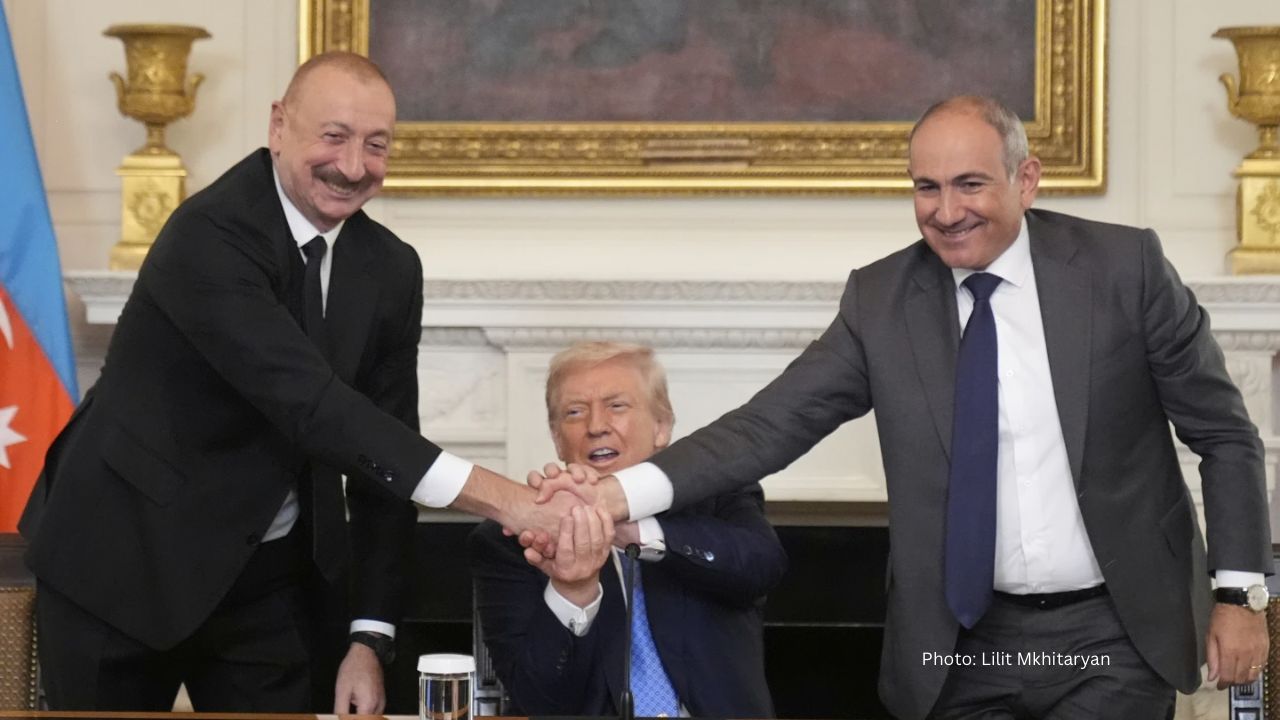A Fragile Peace and a Shifting Power Map in the South Caucasus
Roman Uddin | 28 August 2025
After more than three decades of intermittent violence and frozen diplomacy, the Armenia-Azerbaijan conflict has entered a new and uncertain phase. On 8 August 2025, the two countries initialed the Agreement on the Establishment of Peace and Interstate Relations in Washington D.C., under the mediation of the United States. For the first time since the dissolution of the Soviet Union, both governments formally acknowledged each other’s territorial integrity and pledged to end hostilities. While the agreement offers a fragile hope of stability, it also represents a major geopolitical realignment that places the United States at the center of Caucasian diplomacy, while effectively sidelining Russia, the region’s traditional power broker.
The roots of the Armenia-Azerbaijan conflict run deep into the Soviet period. In 1923, Moscow established the Nagorno-Karabakh Autonomous Oblast within the Azerbaijan SSR, even though its population was overwhelmingly Armenian. This decision, engineered by Joseph Stalin as a balance between Turkish and Persian interests, institutionalized a structural grievance that persisted for generations. When the Soviet Union collapsed in 1991, the local Armenian authorities declared independence, which Azerbaijan rejected. The first Karabakh war (1991–1994) left some thirty thousand people dead and more than a million displaced, most of them Azerbaijanis. Armenia and its allied forces occupied not only Nagorno-Karabakh but also seven surrounding Azerbaijani districts. A Russian-brokered ceasefire froze the front lines but produced no political settlement, and the OSCE Minsk Group failed to deliver a compromise during the following decades.
The status quo was shattered in 2020, when Azerbaijan, backed by Turkish drones and intelligence, launched a rapid campaign that regained most of the lost territories. A Russian-mediated ceasefire halted the fighting after forty-four days, deploying two thousand Russian peacekeepers along the Lachin corridor to protect the remaining Armenian population. Yet the arrangement was unstable. By September 2023, Azerbaijan carried out a one-day “anti-terror” operation, reasserting full control over Nagorno-Karabakh and prompting more than one hundred thousand Armenians to flee to Armenia. The self-proclaimed “Republic of Artsakh” dissolved itself on 1 January 2024. Armenia, disillusioned by Moscow’s passivity during the crisis, turned increasingly toward the United States and the European Union for diplomatic and security guarantees. This geopolitical pivot set the stage for Washington’s entry as chief mediator in 2025.
The August 2025 deal builds on that shift and embodies the end of the Russian-centric framework. Its text emphasizes mutual recognition of sovereignty, renunciation of force, and the creation of diplomatic relations. Crucially, it introduces a new connectivity project: a transit corridor through Armenia’s southern Syunik (Zangezur) region linking mainland Azerbaijan with its Nakhchivan exclave. The corridor remains Armenian sovereign territory, but its construction and administration for ninety-nine years are assigned to a U.S.-backed consortium responsible for developing rail, road, and digital infrastructure. This arrangement gives Washington an unprecedented operational and economic presence in the South Caucasus. At the same time, Armenia and Azerbaijan jointly requested the dissolution of the OSCE Minsk Group, thereby removing the only institution where Russia had maintained formal mediation authority since the 1990s.
By the end of August 2025, optimism remained cautious. The treaty was initialed but not yet ratified by either parliament. Both sides still disputed technical details of border delimitation, the legal status of the corridor, and constitutional amendments demanded by Baku to erase residual Armenian territorial claims. Although small cross-border trade offices have opened and exploratory teams have begun surveying possible transit routes, implementation of core provisions had yet to begin. Sporadic skirmishes persisted in several frontier areas, reminding observers that paper commitments have not yet translated into mutual trust. Nevertheless, the publication of the full text on 11 August 2025 represented a degree of transparency unprecedented in the region’s diplomacy.
Historically, the conflict reflected great-power rivalries as much as local nationalism. Under Soviet rule, Moscow contained tensions by suppressing nationalist movements, and after independence, it preserved leverage by stationing troops and supplying arms to both sides. That system has now unraveled. The new agreement removes Russian peacekeepers and replaces the Minsk Group’s tripartite mediation with direct U.S. facilitation, marking the first clear erosion of Russian authority in the South Caucasus since 1991. Armenia has turned toward closer cooperation with the European Union, the United States, and France, while Azerbaijan accepts limited Western oversight in exchange for formal recognition of its territorial gains.
Yet the accord leaves critical humanitarian and political issues unresolved. It confirms Nagorno-Karabakh as part of Azerbaijan without autonomy or cultural guarantees for its former Armenian residents. The clause on voluntary and safe return remains symbolic, and most displaced Armenians see no realistic path back. Within Armenia, the deal has sparked protests and accusations of capitulation, as critics argue that Yerevan traded tangible assets for an uncertain peace.
Internationally, the agreement signals a profound geopolitical shift. The U.S.-supervised corridor project gives Washington a direct economic and diplomatic foothold in regional infrastructure, aligning with broader efforts to diversify Eurasian connectivity away from Russian and Iranian control. Russia, absorbed in its war in Ukraine, has lost both military leverage and diplomatic initiative. Iran views the new alignment warily, while Turkey welcomes it as strengthening its links with Turkic partners. Peace remains fragile, but a new balance of power is clearly emerging.
Roman Uddin is a Research Associate and Youth Outreach Program Coordinator at Centre for Governance Studies (CGS)
Disclaimer: Views in this article are author’s own and do not necessarily reflect CGS policy
